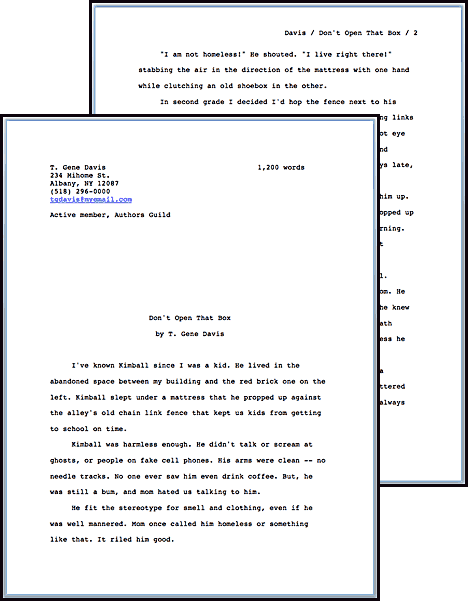As I’ve mentioned in other articles, writing a great story is not enough to sell your story. Among other things, your presentation needs to look professional. If you want to be treated professionally, format your story according to industry standards. You can vary slightly from the standards according to your tastes, but keep close to the standards so as to avoid looking amateurish.
All stories submitted to this blog, or any other publisher, should be in standard manuscript format. That format is different for plays and novels. I’ve been submitting my own stories since the 1980’s and the format has essentially remained the same. Unfortunately, many excellent stories get rejected just because they are poorly formatted.
Don’t feel too bad, if you don’t know standard manuscript format. Surprisingly, many colleges with excellent creative writing courses don’t teach manuscript presentation. I attended what at the time was considered one of the best English departments in the U.S.A. for creative writing and never heard any professor describe proper formatting of short stories for submitting to magazines. Having already been submitting stories for several years before entering college, I was shocked at the formatting of stories shared in writing groups in several classes.
If your manuscript arrives looking like it was formatted for your college class, it makes a poor impression on the editors that view it. If submitting hardcopy, never staple your manuscripts. Paper copies are always paper clipped. Staples irritate editors and result in ripped pages, if not in automatic rejections.
The first page of your manuscript should have your contact information in the upper lefthand corner. This includes name, street address, phone number and email address. Under that, place any important professional membership information, such as SFWA or Authors Guild. Showing you are a member of a professional writers association will impress some editors, and make others yawn, but it never hurts to add the information.
In the upper right hand corner, place the approximate word count of the story. Traditionally, the word count is rounded to the nearest hundred words. These days, it is more and more common to see exact word counts because the computer counts for you. Even with the computer counting, there are discrepancies in word counts. For example, many text editors will count “thirty-eight” as two words, but also count “x-ray” as two words. For that reason, many editors still stick to the rounded word count policy.
The title of the story should appear about half way down the first page. Immediately under the title should be your byline with your pen name if using a pen name. Page numbers never appear on the first page, but should appear on every other page of the manuscript.
All paragraphs should be indented five spaces. All line spacing should be double spaced. The font should be an easy-to-read font, such as Courier or New Times Roman. Sans-serifed fonts are frowned upon for manuscript fonts, because they are harder on the eyes at small sizes. Italics should be presented as underlined text to make them obvious.
The second and all other pages should have a header consisting of the author’s last name, the story title, and the page number. They should be aligned to the right, and each element should be separated by a forward slash.
For visual reference, here is an example of my story, “Don’t Open That Box” in standard manuscript format.
Formatting is quicker if you work from a template. Special writing applications, such as Scrivener provide industry standard templates to make your life easy. You can even create your own templates, if you know you need a non-standard format more than once in a while.
Finally, check for variations in standard format listed on submission guidelines for the publisher you are submitting your manuscript to. The most common variation is the request to leave identifying information off the actual manuscript. However, special fonts and special line spacing are sometimes requested.


Thanks for sharing. Underlining the italics and marking the headers with slashes are new to me, but I’ll definitely include these tips in my next submission.
Also shared to Pinterest. 😉
This is very helpful information. Thanks for sharing this.
This was great info. Knowing what to look for (or even that there was something to look for) I found a perfect template in Word.
Thanks for the tips. I have several articles and a entire book on manuscript formatting and there are differences in each, but I’m glad you explained what you prefer.
*sigh*…no “edit” button! That should obviously have been “an” in the first sentence. (A writing site without an edit option? For shame! LOL)
Helpful. Editors are busy, and no need to distract them with strange, non-standard formatting. Thanks.